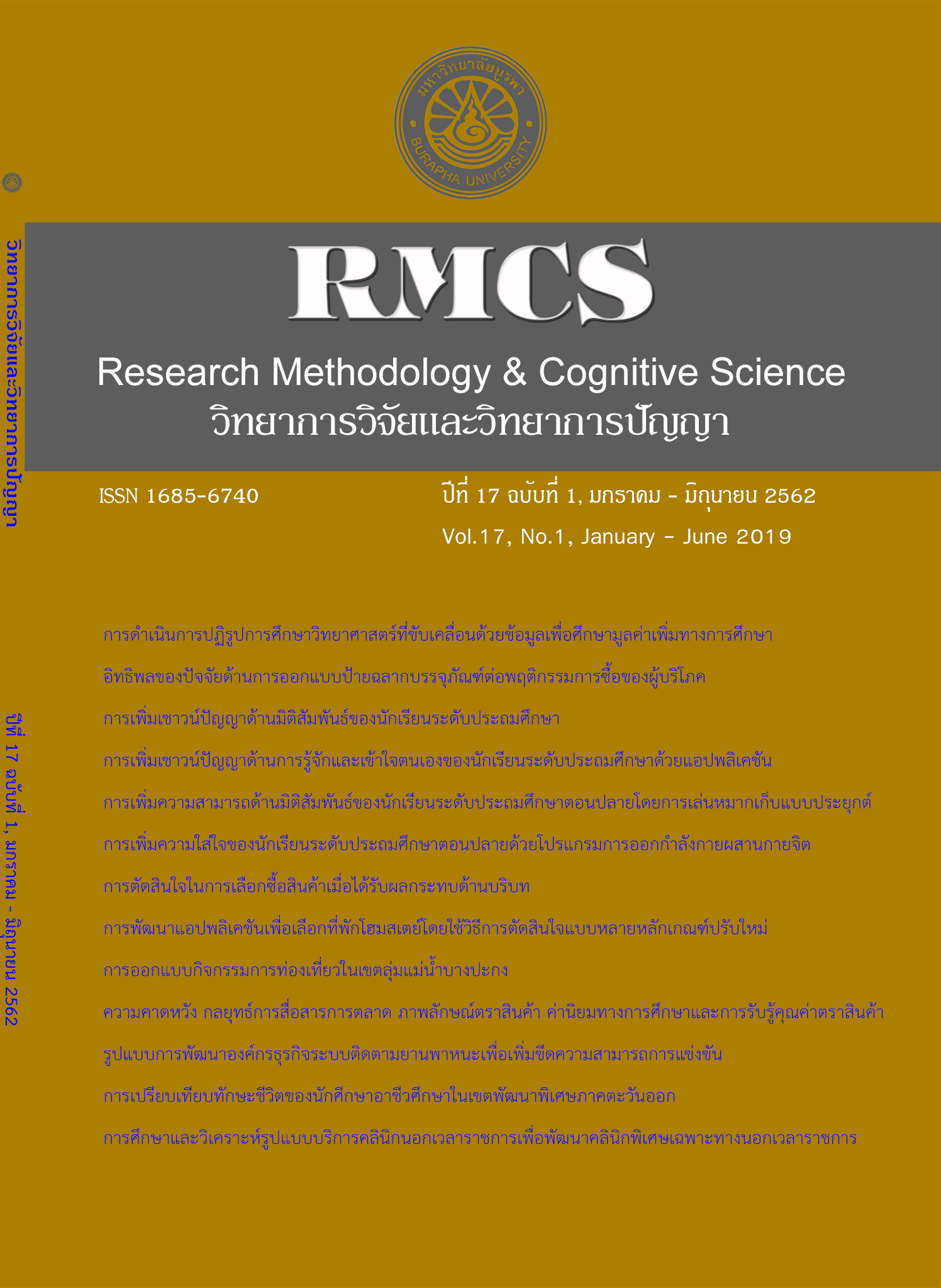Decision Making for Purchasing Products under Context Effects
Main Article Content
Abstract
The research objectives were 1) to study decision-making consequences affected by three context effects i.e., Similarity, Attraction, and Compromise effects under time and no time constraints 2) to study response time distributions of decision making under time and no time constraints. Research sample comprised of 60 enlisted men working at Signal Department, Royal Thai Army, Bangkok in the fiscal year 2558. Research instrument was decision-variable measurement test called Decision Making Information Scripts (DMIS) and designed to measure choice relative frequency and relevant response time of each choice the subjects made, question by question. The DMIS was composed of 52 questions separated into 3 parts, i.e., training (4 questions), choosing one mobile phone from totally two mobile phones (24 questions), and choosing one mobile phone from totally three mobile phones (24 questions).
Research results showed that, under the four levels of the time constraint i.e., no time constraint, 25%, 50%, and 75% time constraints, the relative frequencies of choices were corresponding to the choice probabilities claimed by previous studies for 10, 8, 8, and 8 out of 12 context effect patterns, respectively; and the response times distributed as the Ex-Gaussian and were fitted to the empirical data with BIC = -352.983, -256.010, -239.712 and -216.745, respectively.
Article Details
References
Ashby, F. G., & Maddox, W. T. (1993). Relations between prototype, exemplar, and decision bound models of categorization. Journal of Mathematical Psychology, 37(3), 372-400
Ayre, C., & Scally, A. (2014). Critical values for Lawshe’s content validity ratio: revisiting the original methods of calculation. Measurement and Evaluation in Counseling and Development, 47(1), 79-86.
Bateman, I. J., Munro, A., & Poe, G. L. (2008). Decoy effects in choice experiments and contingent valuation: asymmetric dominance. Land Economics, 84(1), 115-127.
Burnham, T. A., Frels, J. K., & Mahajan, V. (2003). Consumer switching costs: A typology, antecedents, and consequences. Journal of the Academy of marketing Science, 31(2), 109-126.
Busemeyer, J. R., & Diederich, A. (2010). Cognitive Modeling. California: SAGE Publications Ltd.
Chuang, S., & Yen, H. (2007). The impact of a product’s country-of-origin on compromise and attraction effects. Marketing letters, 18(4), 279-291.
Diederich, A. (2003). MDFT account of decision making under time pressure. Psychonomic Bulletin & Review, 10(1), 157-166.
Fraser-Mackenzie, P., & Dror, I. (2009). Dynamic reasoning and time pressure: Transition from analytical operations to experiential responses. Theory Dec, 71(1), 211-225.
Huber, J., Payne, J. W., & Puto, C. (1982). Adding Asymmetrically Dominated Alternatives: Violations of Regularity and the Similarity Hypothesis. Journal of consumer research, 9(1), 90-98.
Kahneman, D., & Tversky, A. (2013). Prospect theory: An analysis of decision under risk. In Handbook of the fundamentals of financial decision making: Part I (pp. 99-127): World Scientific.
Lacouture, Y., & Cousineau, D. (2008). How to use MATLAB to fit the ex-Gaussian and other probability functions to a distribution of response times. Tutorials in Quantitative Methods for Psychology, 4(1), 35-45.
Lawshe, C. H. (1975). A quantitative approach to content validity. Personnel psychology, 28(4), 563-575.
Lewin, K. (1935). A dynamic theory of personality: Selected papers (DK Adams & KE Zener, Trans.). New York: McGraw.
Matzke, D. & Wagenmakers, E. J. (2009). Psychological interpretation of the ex-Gaussian and shifted Wald parameters: A diffusion model analysis. Psychonomic Bulletin & Review, 16(5), 798-817.
Noguchi, T. & Stewart, N. (2014). In attraction, compromise, and similarity effects, alternatives are repeatedly compared in pairs on single dimensions. Cognition, 132(1), 44-56.
Nosofsky, R. M. (1988). Exemplar-based accounts of relations between classification, recognition, and typicality. Journal of Experimental Psychology: learning, memory, and cognition, 14(4), 700.
Nosofsky, R. M. (1992). Similarity scaling and cognitive process models. Annual review of psychology, 43(1), 25-53.
Payne, J. W. (1976). Task complexity and contingent processing in decision making: An information search and protocol analysis. Organizational Behavior and Human Performance, 16(2), 366-387.
Payne, J. W., Bettman, J. R., & Johnson, E. J. (1988). Adaptive strategy selection in decision making. Journal of Experimental Psychology: learning, memory, and cognition, 14(3), 534.
Pettibone, J. C. (2012). Testing the effect of time pressure on asymmetric dominance and compromise decoys in choice. Judgment and Decision Making, 7(4), 513.
Roe, R. M., Busemeyer, J. R., & Townsend, J. T. (2001). Multialternative decision field theory: A dynamic connectionst model of decision making. Psychological review, 108(2), 370.
Sedikides, C., Ariely, D., & Olsen, N. (1999). Contextual and procedural determinants of partner selection: Of asymmetric dominance and prominence. Social Cognition, 17(2), 118-139.
Shugan, S. M. (1980). The cost of thinking. Journal of consumer research, 7(2), 99-111.
Simonson, I. (1989). Choice Based on Reasons: The Case of Attraction and Compromise Effects. Journal of consumer research, 16(2), 158-174.
Simon, H. A. (1957). Models of man; social and rational. New York: Wiley.
Townsend, J. T., & Busemeyer, J. R. (1989). Approach-avoidance: Return to dynamic decision behavior. In C. Izawa (Ed.), Current issues in cognitive processes: The Tulane Flowerree Symposium on Cognition (pp. 107-133). Hillsdale, NJ, US: Lawrence Erlbaum Associates, Inc.
Trueblood, J. S., Brown, S. D., Heathcote, A., & Busemeyer, J. R. (2013). Not just for consumers: Context effects are fundamental to decision making. Psychological Science, 24(6), 901-908.
Tversky, A. (1972). Elimination by aspects: A theory of choice. Psychological Review, 79(4), 281-299.
Wilson, F. R., Pan, W., & Schumsky, D. A. (2012). Recalculation of the critical values for Lawshe’s content validity ratio. Measurement and Evaluation in Counseling and Development, 45(3), 197-210.
Yang, S., & Lynn, M. (2014). More evidence challenging robustness and usefulness of the attraction effect. Journal of Marketing Research, 51(4), 508-513.

